Strange things are happening to the income trends seen in our annual reader survey of late. Pre-COVID, the national average income figures reported by our readers made modest, and likely somewhat disappointing, gains year over year from 2016 to 2019 (see chart). Ever since COVID hit, however, incomes have zig-zagged: an understandable drop during the lockdown year of 2020 followed by an average year-over-year gain of $20,000 per OD in 2021, then a second income drop in 2022 and another big jump this year. In fact, the national average optometric income reported for 2023 stands at $194,020, representing a gain of 12.2% over 2022’s figure of $172,914.
And yet, plenty of ODs have reason to grumble. “It is a good income but the stress of managed care and government mandates makes the income feel as if it’s not enough,” wrote Lois Kessen, OD, a Midwestern solo practitioner, in this year’s survey.
How did the profession’s earnings go from “slow and steady” to “wild and woolly” in recent years? Declining insurance reimbursements and a nasty jump in operating costs due to inflation are taking their toll on those who reported income declines year over year. But optometrists who notched gains consistently pointed to higher patient volume as the driver, more so than charging higher fees or increasing product sales.
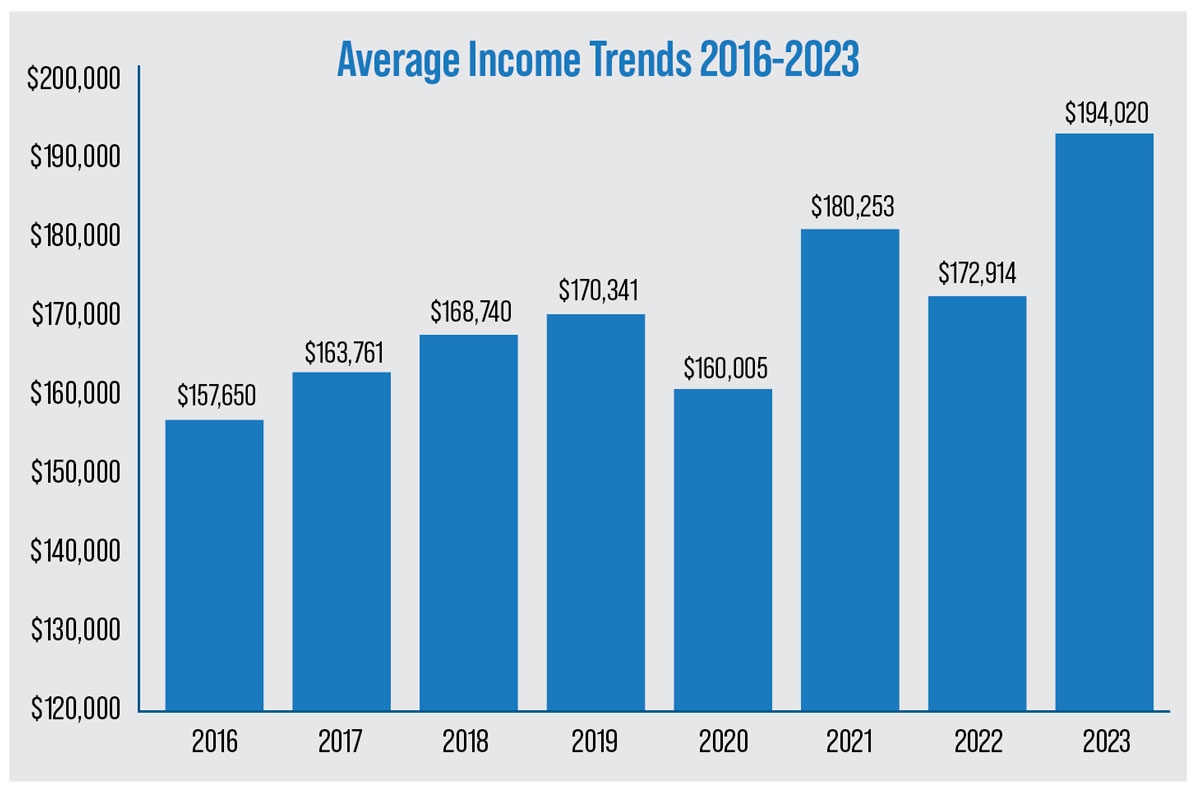 |
| Click to enlarge. |
While private practice optometry continues to dwindle as a proportion of the workforce—younger ODs are more often employed, either by choice or necessity—those who are self-employed can rack up some really healthy earnings. For the lucky few whose practice growth reaches escape velocity, incomes will soar, especially when their offices are able to juice patient volume.
“Growth of the business has been showing that additional staff is a very good ROI,” commented Michael Campbell, OD, a self-employed private practitioner from the South.
“Now that I’m in private practice, I’m finally earning my worth!” enthused Lisa Greene, OD, another Southerner who’s her own boss.
These and other success stories are heartening. But plenty of ODs feel their income remains about the same even when they give it their all.
“My patients are coming to me for an exam and then going elsewhere to buy their glasses, either online or at a box store. I’m working harder for less,” one Southern optometrist wrote. “Even though my medical model is increasing medical care, it requires me to do more work for less money than when I’m selling nice glasses to people like I did when the economy was stronger.”
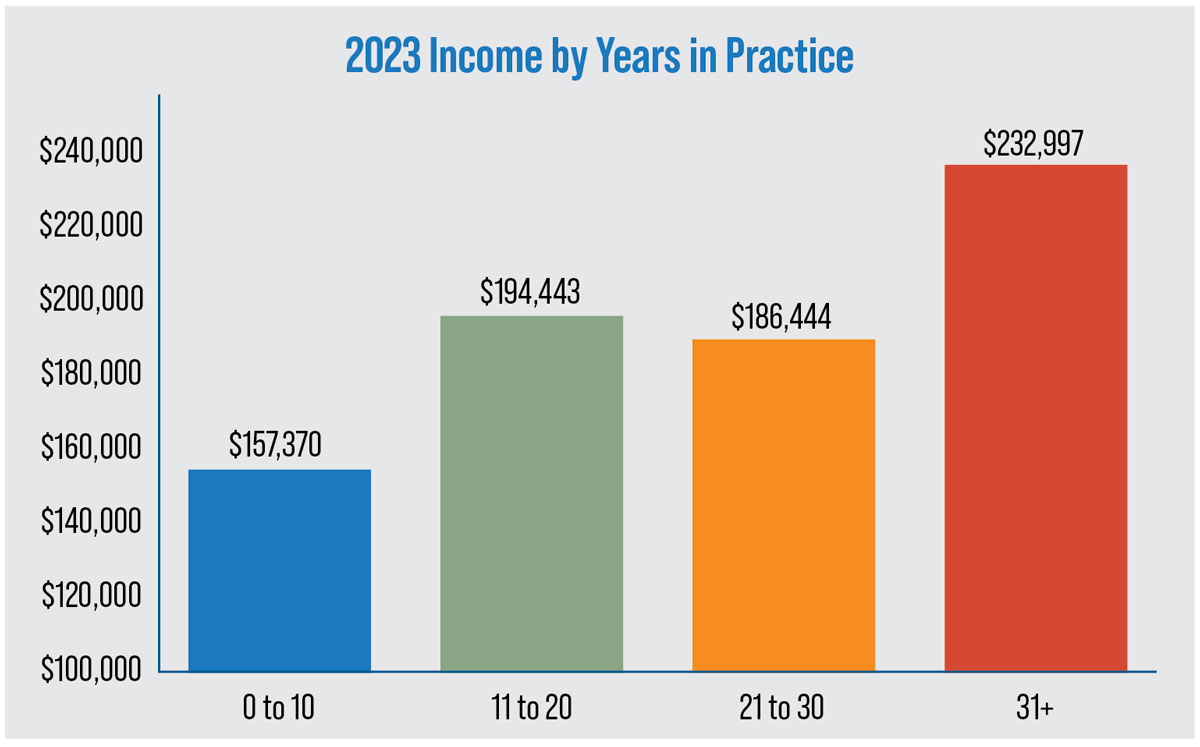 |
| Click to enlarge. |
Those are some of the big-picture trends evident in our 2023 reader survey, in which 337 optometrists shared their income data and, often, a piece of their minds.
“I am working more than ever and have had my most productive year when it comes to patient volume, yet the wage inflation combined with decreased insurance reimbursement has resulted in a continued downward trend in net income,” wrote one OD who practices in the West. “This is very frustrating given that many other career tracks enjoy year-over-year increased compensation with years of experience and inflation-related wage adjustments. Thank goodness I love what I do!”
Let’s dig into the numbers reported this year, looking in particular at various subsets of the responses to give more color to the overall income numbers.
As always, be mindful that while we ask the same survey questions, the responses we compare from year to year come from different individuals, making trend analysis tricky, especially among a smaller cohort. The results here offer an illuminating look at the profession but aren’t considered statistically rigorous, particularly year-over-year comparisons.
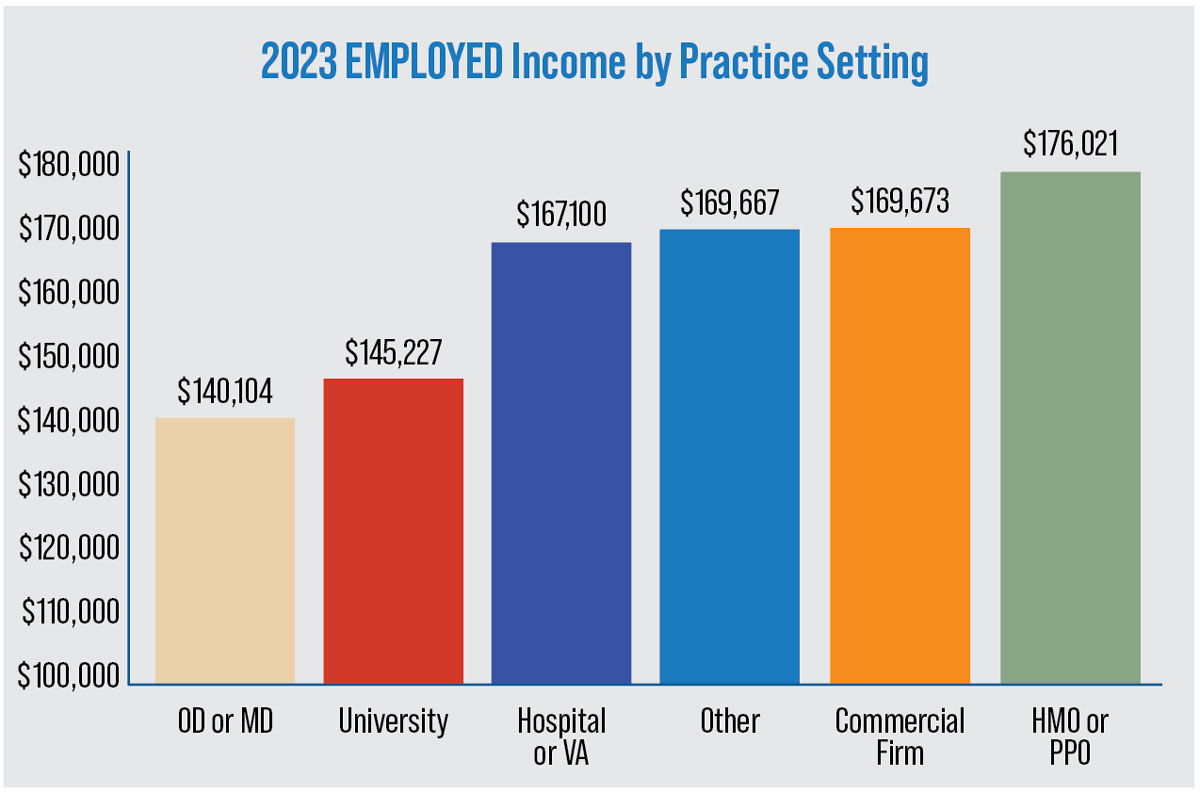 Click image to enlarge. |
Private Practice Fuels Income
Those who did best in our 2023 income survey demonstrated two clear traits: seniority and self-employment. Optometrists who’ve been practicing for 31 years or more netted $232,997 on average this year, while those with zero to 10 years of experience only earned an average of $157,370, an income differential of over $75,000 between the cohorts.
An even bigger gap was seen in the category of employment status. While only 42% of respondents identified as self-employed, bosses earned $100,000 on average more than employees, with a whopping $255,008 for self-employed ODs this year vs. $154,963 for those who are employed by another.
The cohort with the highest earnings in the 2023 survey was self-employed ODs in partnership or group private practices, who told us they expect to net $315,159 on average, again making the case for the efficiencies that come with scale.
Those in solo private practice earned the still-impressive average of $212,251, but the distinction is clear: when thinking about practice size as an income driver, bigger is better. One solo practice OD (again from the South!) articulates this very path to success from his view in the trenches: “The number of people that I have seen has been going up, and as a result I could benefit from having another doctor in my practice part time to start and hopefully to build up to full-time. Then that would increase my gross revenue and the higher volume would allow me to streamline and increase my net.” Go for it, doc—make that hire!
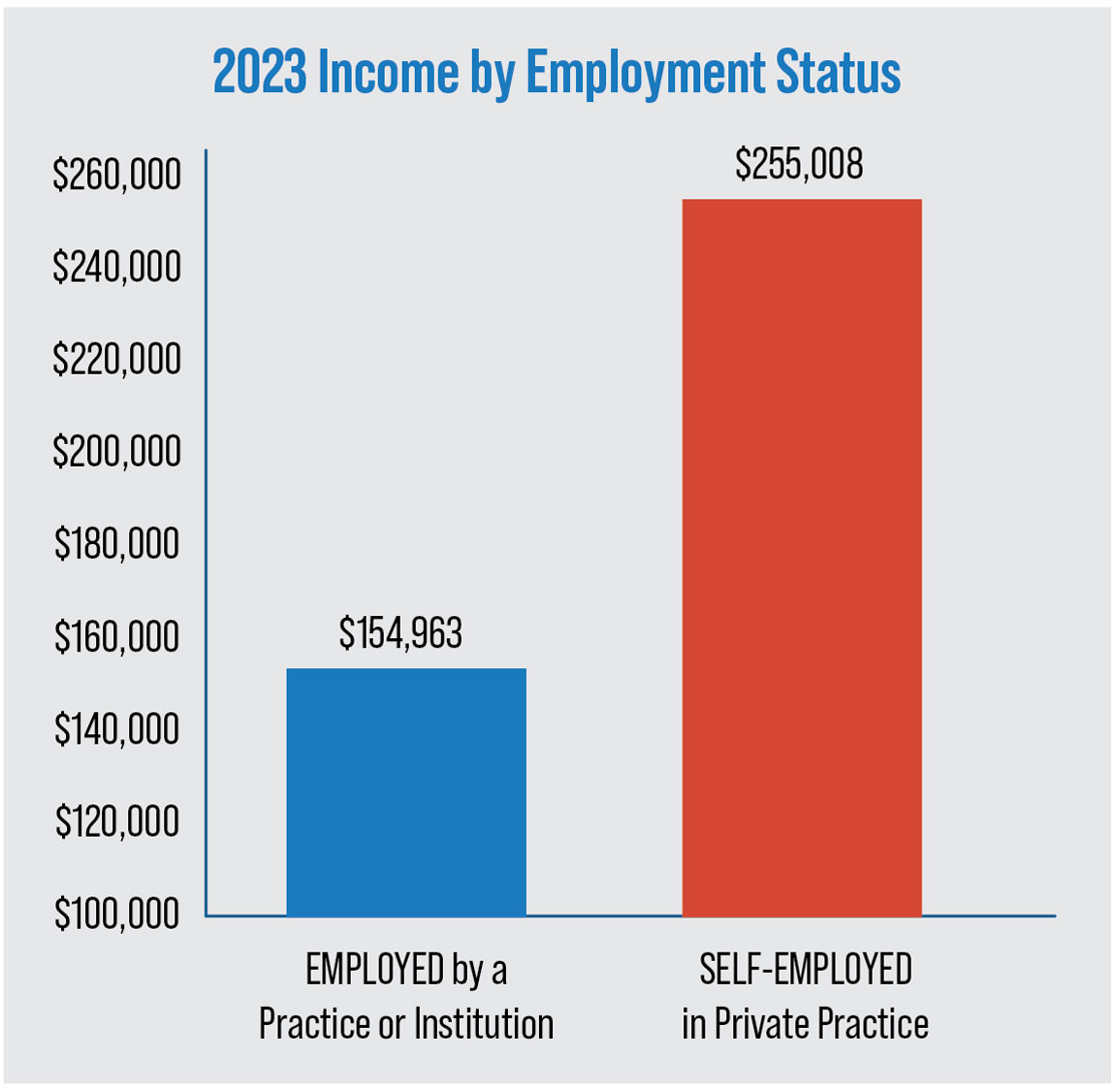 |
| Click to enlarge. |
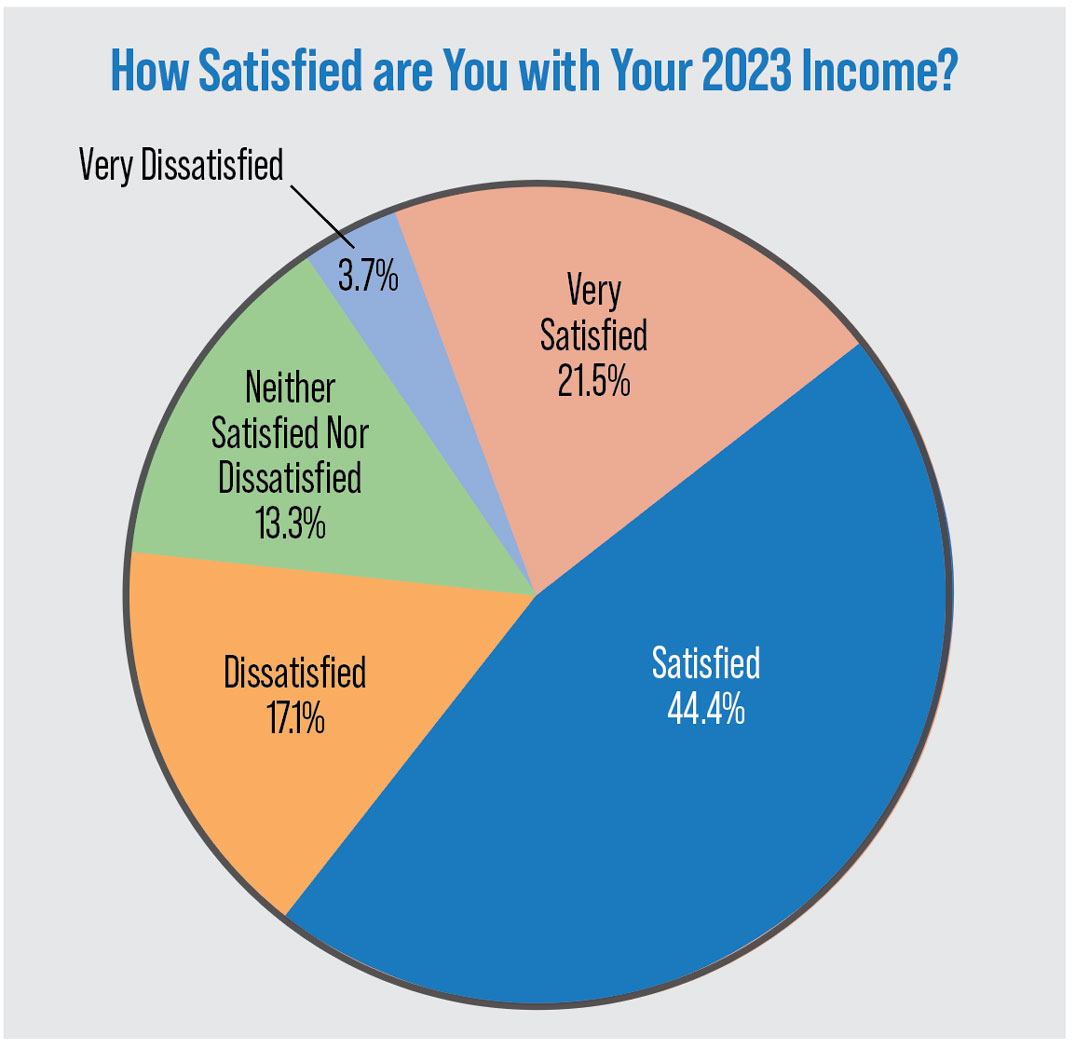 |
| Click to enlarge. |
Employed ODs: Lower Earnings, Less Stress
If you take the $154,963 average income for the group of optometrists who work for someone, there’s a considerable spread in earnings depending on who’s cutting the checks. The lowest pay comes from private practices, as those employed by an OD or an MD earned just $140,014 on average. The best payers were HMO/PPO companies, at $176,021.
Some of the better paying jobs are also more demanding. “I work way harder than what others do in much less complex care facilities,” wrote Logan Kiekhafer, OD, a Midwestern doc who’s employed by a hospital.
Age is a significant factor in the lower average earnings for employed ODs, as they tend to be earlier on in their careers (though that’s not always the case). Student loan debt is a notorious albatross around the necks of many, but there’s also a lot of happiness among younger employed ODs. “I’m a relatively newer graduate clearing more than what I’d ever thought I’d make,” one young optometrist from the West wrote.
And another employed optometrist from the West put it simply: “I make enough to support my family doing a job that I love.”
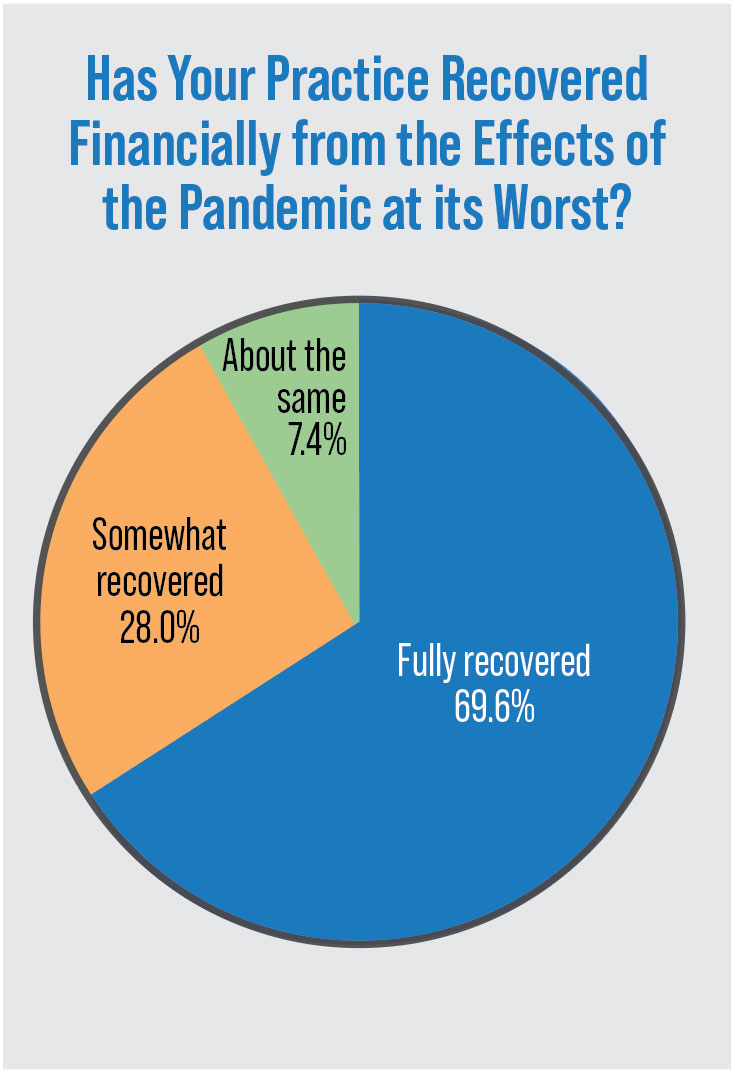 |
| Click to enlarge. |
By and large, ODs are happy with their profession and what they earn practicing it. Only about 21% of readers were disenchanted with their incomes: 17.1% said they were dissatisfied and 3.7% were very dissatisfied. By contrast, 44.4% said they were satisfied and another 21.5% called themselves very satisfied, giving two-thirds of the sample overall a positive outlook this year.
Looking at employment status among the satisfied vs. dissatisfied question, we see that, well, money ain’t everything. Of those who said they were satisfied or very satisfied, 56.2% are employed ODs and 43.8% are self-employed. Wrote one senior Midwestern optometrist: “I have no stress as a first-time employee. I was in private practice the past 37 years. I earn less now but have no worries.”
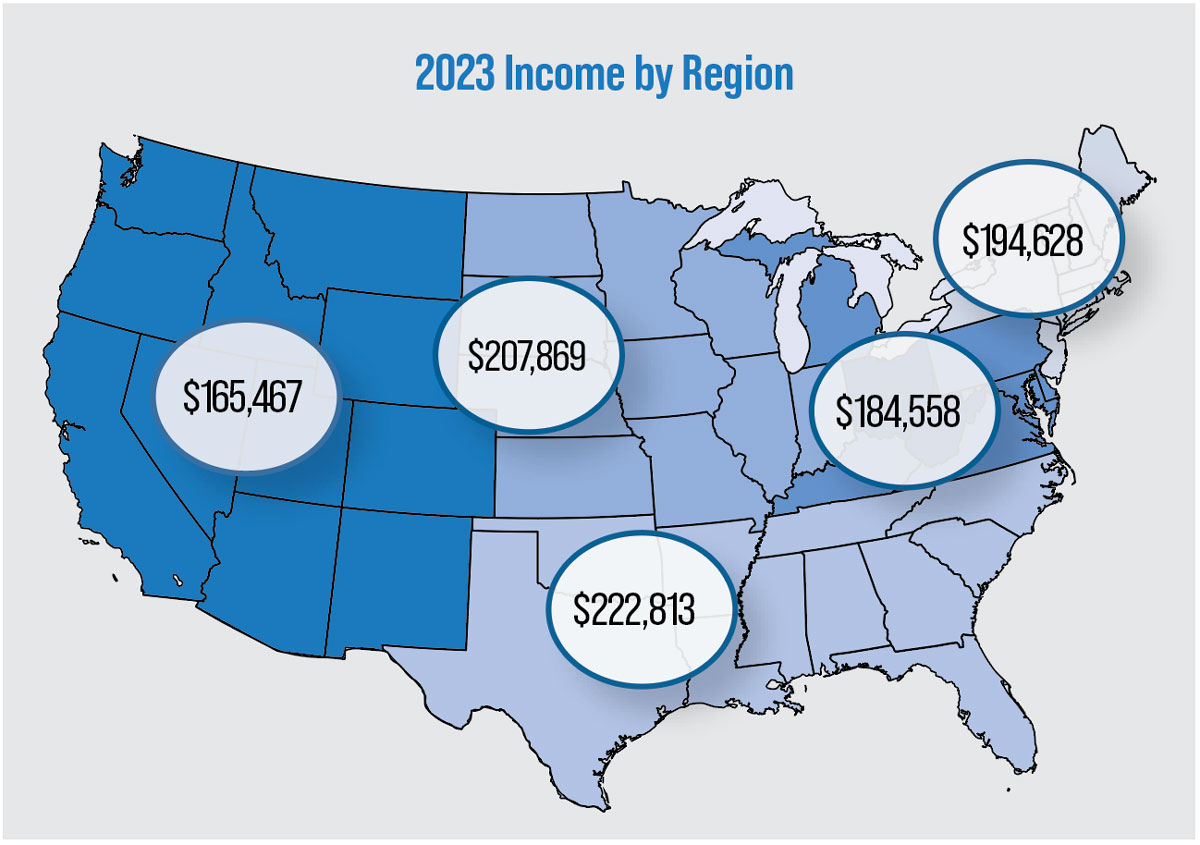 |
| Click image to enlarge. |
Geography and Gender
These two categories also can swing the numbers in substantial ways.
As in so many professions, women in this field earn substantially less than men. Female ODs reported an average 2023 income of $151,271 vs. $235,162 for male ODs, meaning that women ODs earned 64.3% of what their male counterparts did. This is one more manifestation of structural and cultural factors in America that perpetuate income inequality between the sexes.
Specific to optometry, it’s worth noting that fewer female ODs are self-employed (34.1% for women vs. 48.2% for men) and, as noted above, self-employment is the biggest driver of income growth.
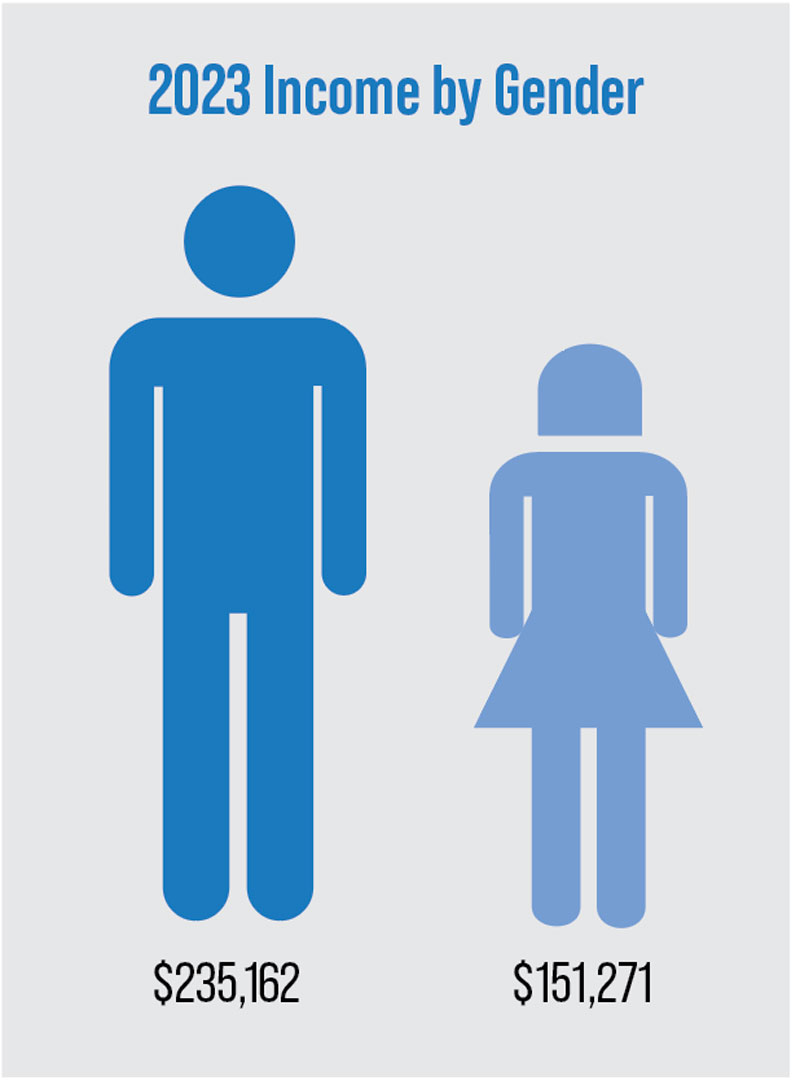 |
| Click to enlarge. |
Another factor at work: The women ODs in our survey also skewed younger than the men, and higher earnings accrue later in one’s career. The “years in practice” breakdown by gender was as follows:
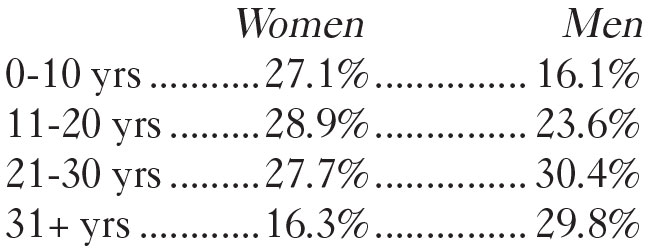 |
Drilling down into income levels within each of the years in practice cohorts, we find that the gender pay gap is most pronounced in the 21-30 year bracket, where male optometrists earned $101,490 more than female ODs on average. The men in this category took home $234,395 while the women netted $132,905. The full list of gender pay disparities by years in practice—all favoring men—were as follows:
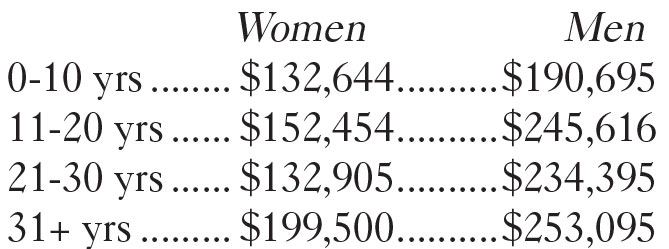 |
Needless to say, we hope to see the gender gap in income shrink in the coming years as more female ODs ascend to positions of seniority in the profession. Of course, headwinds that exist beyond optometry will continue to make such progress challenging.
Looking at regional differences in the United States, practice location also created a notable spread in the income numbers reported. The most striking difference is, frankly, the West vs. everyone else. Western optometrists earned, on average, $165,467—the lowest of all the regions tracked. The highest earners were found in the South, where average incomes were reported to be $222,813, a difference of more than $50,000 per OD based on region of the country alone. When averaging non-Western US regions as one bloc and comparing that to the West, there’s still a $20,000 penalty for practicing in the West.
“My income has not kept up with inflation,” said one optometrist practicing in the West. “I’m not making much more today per patient than I did in 1995 when I graduated.”
Another established solo practitioner in the West describes her struggles to maintain profitability of her practice as follows: “I have not had problems with staff turnover the way many of my colleagues have, but increased salaries are really making it difficult. Minimum wage increases have more than doubled my payroll. While I definitely feel that these increases are deserved, I simply don’t have the money.”
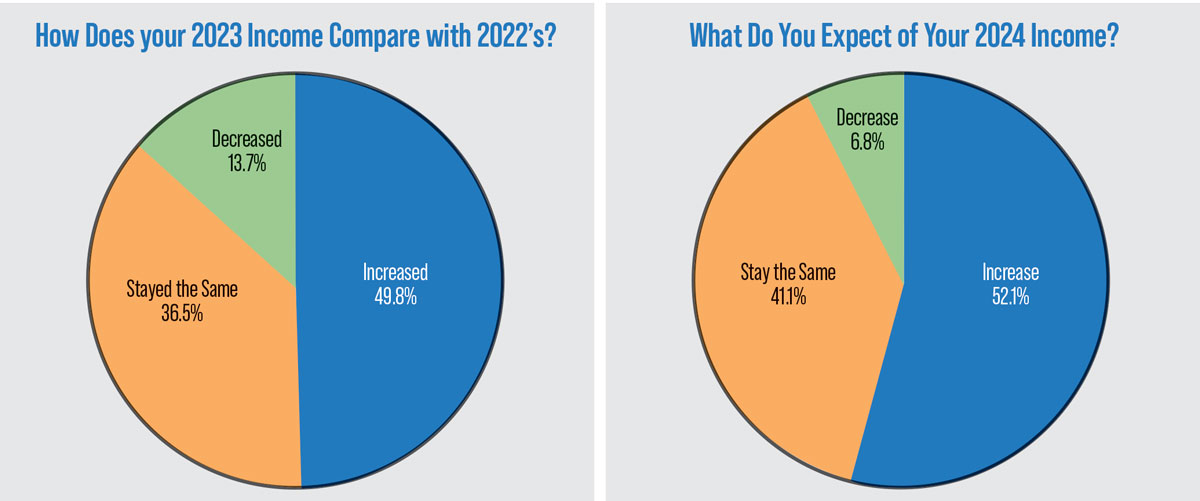 |
| Click image to enlarge. |
Winds of Change
In a year with some notable and concerning income disparities across several metrics, at least one disruptive force seems to have abated: the effects of the COVID pandemic. Only 7.4% of respondents said its impact was the same as ever, while 69.6% declared their practices fully recovered. Instead, those who felt outsized effects on their income this year pointed to one sadly familiar factor—declining insurance reimbursement—and another that’s been more of a concern only recently: inflation.
“My income has only stayed the same due to increased work hours/efficiency, but reimbursements and patient spending has decreased while cost of good sold has increased,” a Midwestern optometrist conveyed in his survey response.
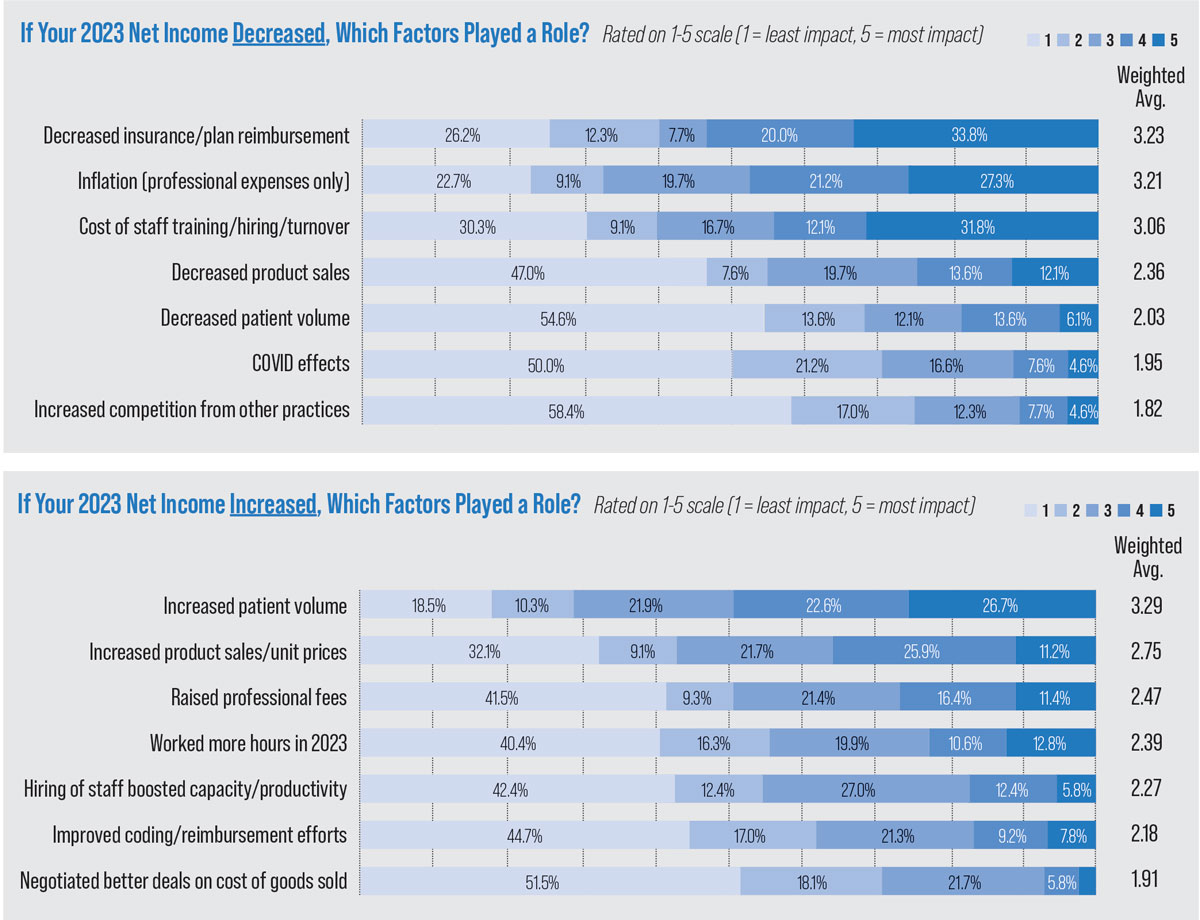 |
| Click to enlarge. |
Nevertheless, more than half of respondents anticipate gains in 2024, as 52.1% said they expect their incomes to increase. Only 6.8% are bracing for a decrease, while 41.1% expect to earn pretty much the same as this year.
Some of that is strategic, as one solo practitioner from the West explained: “I choose to hold my salary here so that I have more funds available for new equipment, bonuses, etc. It keeps me flexible and able to adapt to new economic challenges.”
Others, especially employed optometrists, feel more powerless to effect big increases but often point to the silver lining of work-life balance and a comfortable standard of living. Practicing optometry “supports my family with a nice lifestyle,” one wrote. At the end of the day, that’s the clearest path to contentment.

